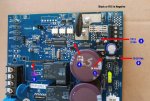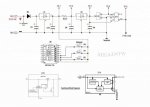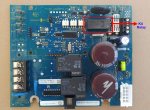So I just had this opportunity to replace a bad thermistor on the AQR board and would like to share the easy way on how to diagnose a faulty thermistor. First off, the board that I worked on belongs to a friend who doesn’t really know how to solder. So I came up with the idea of using a screw terminal (Digi-Key part# ED2561-ND) to mount the thermistor on. This should enable him to replace the thermistor in the future without having to solder. The original thermistor is AS32 2R025 which has a wider lead wire footprint but the available replacement on hand is SL32 2R025. The latter has a high failure rate due to overheating compare to the AS32. If your PCB footprint can accommodate both types, then you will be far better off using the AS32.
As observed, the thermistor solder pads are larger with multiple through holes to absorb the heat being emitted by the thermistor during normal operation. I had to bump the solder tip temp to 1200°F for this mod. I removed the plastic sleeves and positioned the screw terminals to accommodate both types of thermistors.

Good Thermistor:
If the thermistor is good, the voltage reading on the display matches the measured voltage from the thermistor lead farthest from the Red terminal on the board as shown. Make sure the Blk test lead is on the Negative side (not Ground) which is the black terminal or to the R15 (.015 Ω) link as shown in the pic.

Bad Thermistor:
The thermistor was intentionally removed to simulate or replicate a bad thermistor for this purpose. The measured voltage and the voltage reading on the display did not match the voltage reading across the Blk and Red terminals.


Hayward Aquarite vs SwimPure Plus PCB:
The Swimpure Plus model used Cantherm MF73T-1, 2Ω@18A, Ø20mm thermistor. As observed, I can touch and hold the thermistor on my SWP like forever during normal operation without getting burned. You may notice, the SWP board has an extra 24VDC relay labeled as “K4”. I have yet to dig deeper on that!
OTOH, do not dare to touch the SL32 or the AS32 series Thermistors when chlorinating, or you’re gonna swear by it. You’ve been warned, Thermistors on the AQR’s do overheat and too hot to touch. Unfortunately, I misplaced my handheld IR thermometer to give you the numbers. Also, the oil from our skin will adhere to the thermistor making it more susceptible to premature failures.
Personal Conclusion: If your Hayward SWCG has the PCB as shown on the right-hand side below then you will probably enjoy many years of chlorinating without having to replace the thermistor. Hence my vote, hands down!

As observed, the thermistor solder pads are larger with multiple through holes to absorb the heat being emitted by the thermistor during normal operation. I had to bump the solder tip temp to 1200°F for this mod. I removed the plastic sleeves and positioned the screw terminals to accommodate both types of thermistors.

Good Thermistor:
If the thermistor is good, the voltage reading on the display matches the measured voltage from the thermistor lead farthest from the Red terminal on the board as shown. Make sure the Blk test lead is on the Negative side (not Ground) which is the black terminal or to the R15 (.015 Ω) link as shown in the pic.

Bad Thermistor:
The thermistor was intentionally removed to simulate or replicate a bad thermistor for this purpose. The measured voltage and the voltage reading on the display did not match the voltage reading across the Blk and Red terminals.


Hayward Aquarite vs SwimPure Plus PCB:
The Swimpure Plus model used Cantherm MF73T-1, 2Ω@18A, Ø20mm thermistor. As observed, I can touch and hold the thermistor on my SWP like forever during normal operation without getting burned. You may notice, the SWP board has an extra 24VDC relay labeled as “K4”. I have yet to dig deeper on that!
OTOH, do not dare to touch the SL32 or the AS32 series Thermistors when chlorinating, or you’re gonna swear by it. You’ve been warned, Thermistors on the AQR’s do overheat and too hot to touch. Unfortunately, I misplaced my handheld IR thermometer to give you the numbers. Also, the oil from our skin will adhere to the thermistor making it more susceptible to premature failures.
Personal Conclusion: If your Hayward SWCG has the PCB as shown on the right-hand side below then you will probably enjoy many years of chlorinating without having to replace the thermistor. Hence my vote, hands down!

Last edited:







